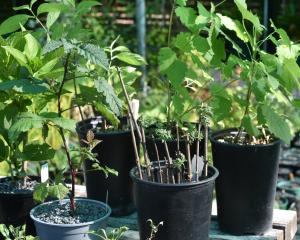Get on top of weeds now or you'll have more work later, says Gillian Vine.
As the ground warms up in spring, seed germinates quickly; not just the carrots and beetroot, but often an impressive array of weeds.
Many of them are annuals but can be mistakenly assumed to be perennials because they germinate in autumn and sit quietly over winter before taking off in warmer conditions.
Speedwell (Veronica persica) is an example of this cunning behaviour, which gives it a head start on the slowcoaches, and its tiny blue flowers are often seen when other weeds are just starting to form buds.
Another sneaky chap is groundsel.
Because it has a very short life cycle, it pops up, then flowers and seeds in no time flat, so overlapping generations are common in the garden.
Groundsel has another nasty attribute: like its relative, ragwort, it is poisonous.
These two are not the most dangerous.
That dubious honour probably goes to the arum lily (Zantedeschia aethiopica), one the National Poison Centre says is on its top 10 list of plants most frequently causing poisoning.
The Italian arum (Arum italicum), with its cream-marked leaves, is also toxic to animals and humans.
Poisonous weeds are sometimes eaten because they look like edible ones.
For example, deadly hemlock, or carrot fern (Conium maculatum), looks rather like its edible relative, parsley, but fortunately its nasty smell distinguishes it.
All parts are poisonous, even the dry canes.
Teach children which plants are poisonous and why they never should eat anything they are unsure about. If they do and it stings or tastes nasty, they should spit it into their hands and run for adult help.
The spat-out material may be vital in identifying what they have eaten. Some weeds cause allergic reactions, such as skin rashes.
The spurges (Chamaesyce and Euphorbia species) belong to a group of plants noted for milky sap or latex, which is poisonous or causes skin rashes, so wear gloves when handling them.
Cleavers, or sticky-burr weed, can raise weals on the skin, while European or common nettle (Urtica urens) and our five native nettles are notorious for their stinging hairs, especially perennial tree nettle (U. ferox).
Common nettle is not as dangerous but can still give an irritating sting, thanks to the bristles (trichomes) on the serrated leaves and stems.
Nettles do have a useful purpose, though, as an important food for caterpillars of the native red admiral butterflies and the rarer yellow admiral.
Some people like to eat nettles, saying cooking tames the prickles and steamed young leaves taste like spinach.
Other edible weeds include dandelions (blanch under a flowerpot to reduce bitterness), puha and chickweed.
In all cases, only the youngest leaves are picked and it is vital to be certain what is being harvested.
However, most of us just want to get rid of weeds.
Hoeing and hand-weeding are a good way to kill annual weeds, a surprising number of which are resistant to weedkillers.
Don't leave hoed-out ones lying on the ground, though, as those in flower will quickly seed in a last-ditch effort to regenerate. Perennial plants are those that pop up year after year.
Dandelions, docks and lawn daisies (Bellis perennis) are among the most common, while periwinkle (Vinca major) and aluminium weed can form large mats in shady places.
Both plants grow from stem pieces, not seed, and can be treated with a glyphosate-based product such as Roundup or Weed Weapon.
As glyphosate kills everything it touches, consider what could be affected by spraying.
Because of its broad-brush approach, glyphosate is not suitable for lawns; instead use a spray designed to control broadleaf weeds but leaves grass unaffected.
Where damp lawns have hydrocotyle or buttercups, sprinkling them with lime a week or two before spraying seems to give a better kill rate.
If you balk at using chemicals, individual taprooted weeds can be cut just below the ground and salt put on the cut before it dries.
Other natural controls include baking soda solution to zap oxalis and vinegar to treat liverwort.
The compost bin benefits from green waste but do not put in taproots of perennial weeds unless they have been killed by putting them in a bucket of boiling water or placing them in a black plastic bag, tying the top firmly so no light gets in and leaving for six months.
Above all, try to win the war early in the season to reduce the workload later.
Start with the annuals, getting them before the flowers appear. Dig out baby docks, dandelions and Californian thistles.
With other perennials, such as docks, if time (or energy) is in short supply, cut off flower buds so that a new generation of weeds cannot pop up, then deal with the mature plants in small bursts later.











